Hole in the Clouds
Sep 6, 2009
There will come a day when nobody cares about Alabama football any more. True, we're not there yet. We'll probably have single-payer health care in the United States long before the Crimson Tide roll over and play dead.
As I write this, Alabama is losing its first game of the season 16-17, to Virginia Tech. They're playing in Atlanta tonight, in the Georgia Dome, but some sunny Saturday very soon, Bryant-Denny stadium in Tuscaloosa will once again look exactly like this.
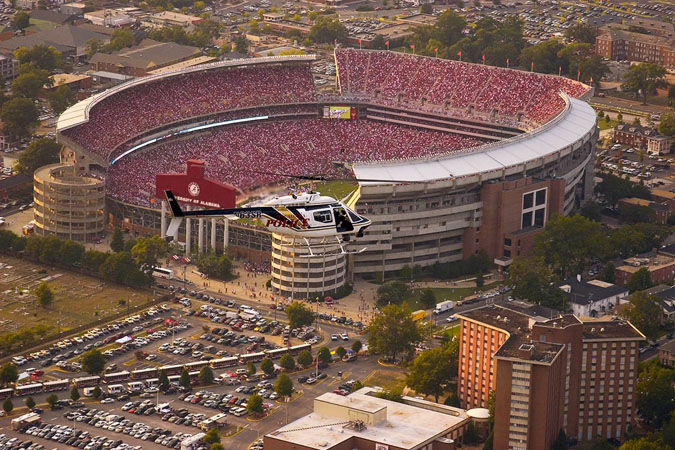
University of Alabama
Tuscaloosa
sports
football
Alabama
(Image credit: unknown)
Aug 30, 2009
The supply closet at the back of Tommy Flowers's math classroom at University Place Middle School in Tuscaloosa has won official recognition as the world's smallest museum.
Mr. Flowers, who has been teaching for 25 years, has assembled a collection of Edgar Allan Poe artifacts, including plastic hearts, dozens of photos, a skull, and of course, a skeleton. He says he became fascinated with Poe when he was himself in junior high school, and he tries to weave Poe's stories and poems into his students' daily lessons.
The fact that he teaches math, not literature, has not been an obstacle: he wants his students to take inspiration from Poe as they cultivate their imaginations to get the most out of life. Also, he wants them to calculate the square footage of his museum--the answer to that is 22, which is the magic number that got Edgar's Closet desgnated as smallest museum in the world.
"I d like a few visitors," said Mr. Flowers. "But more than anything, I'd like to see a few teachers have museums in their closets."
All five Stein boys went to University Place when it was an elementary school. It has recently added middle school grades as part of the Tuscaloosa City Board of Education's scheme to re-segregate the public schools. So far, there have been numerous complaints and petitions, but no lawsuits, so it's working.

Tuscaloosa
Alabama
University Place School
museum
Edgar's closet
Tommy Flowers
Edgar Allan Poe
(Image credit: unknown)
Aug 5, 2009

This photo is ten years old now. Since then our five boys have rarely shown up in the same time zone, much less the same picture frame--this is an important document in family history.
The original negative is gone; there may be some high-resolution prints around somewhere, but I'm not sure where. What I've got on my computer is a scratched, speckled, and stained scan comprising just a handful of pixels.
This gussied-up version is only arguably better than the straight scan. Whatever: from left, in order of age, that's John, Ted, Joe, Allen, and Hank.
Tuscaloosa
Alabama
John Stein
Joe Stein
Ted Stein
Allen Stein
Hank Stein
Forest Lake
(Image credit: Carol Stack)
Oct 21, 2009

For many years now, as the University of Alabama has expanded its football stadium, it's been interested in a small piece of land across the street from the stadium that was home to Temple Emanu-El of Tuscaloosa. The university and the congregation finally agreed to a land swap, and a new synagogue building is now under construction across campus. This past month, the frame went up.
It's not clear what the university will do with its new land--"Some more game-day something or other," according to Anna Singer, who chairs the Temple Emanu-El building committee.
University of Alabama
Tuscaloosa
Alabama
cranes
(Image credit: Anna Singer)
Oct 30, 2009
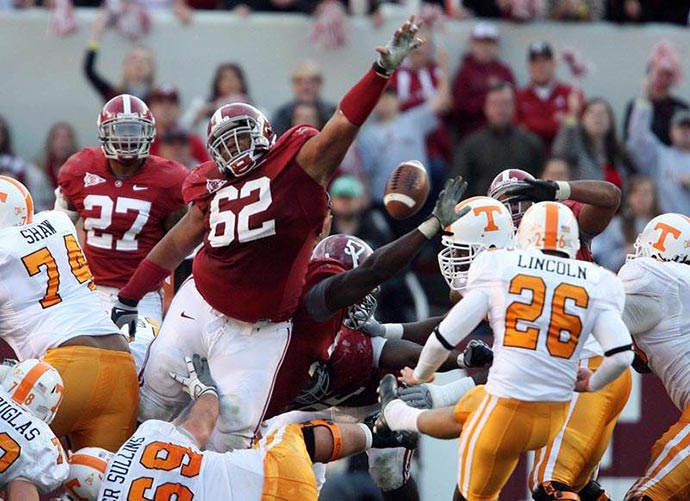
Please forgive me for writing here about Alabama football--just this once, I promise, at least till next year.
Some people don't like football. And even among those who do like football, some don't like Alabama football. All I can say is: better luck in your next life.
Nobody doesn't like Terrence Cody--Mount Cody--the unheralded defensive lineman from Mississippi Gulf Coast Community College who showed up for practice in Tuscaloosa weighing 400 pounds. Off the field, they say, he's a gentle, teddy bear sort of guy, who likes cartoons on TV and sleeps on Spiderman sheets. On the field, he's not gentle; Alabama's defense is ranked number one in the nation, and on that defense Cody has participated in more than his share of tackles and sacks. Last Saturday, he saved a close game for the Tide by blocking two field goal attempts, including one in the final seconds of the game.
But Mount Cody's value to the team doesn't really show up in the formal statistics. Basically, he is so big and strong that the opposing team will need two guys to contain him. This double-teaming gives his teammates a numerical advantage; because of Cody, somebody else is wide open to make more tackles and sacks.
Last Saturday, Tennessee put two guys on Cody, the Sullins brothers, identical twins who are big, strong, experienced offensive linemen. They each weigh something like 275 pounds. Cody has trimmed down a bit; even at 400 pounds he had moves, but now at 365 he can almost run. Still, he outweighed either of the Sullins boys by a good 90 pounds. Several times during the game, double-teaming didn't work to stop him; he would swat the first guy out of the way before the second guy showed up to help--and when Cody gets moving, it might take three or four guys to stop him.
Bama has a number ofl exciting players, including defensive linebacker Rolando McClain, who seems to be a football genius, always guessing right about what the other guys are going to do with the ball. On offense, there's the ridiculously fast receiver Julio Jones and the running back Mark Ingram, a sort of zombie runner who won't stay dead.
But last week was all about Mount Cody. Here he is, number 62, blocking a kick., Notice the Tennessee player lying down in front of him, number 69--that's one of the Sullins brothers, just trying to do his job.
Tuscaloosa
sports
football
Alabama
Crimson Tide
Terrence Cody
Mount Cody
(Image credit: Tuscaloosa News)
Nov 11, 2009
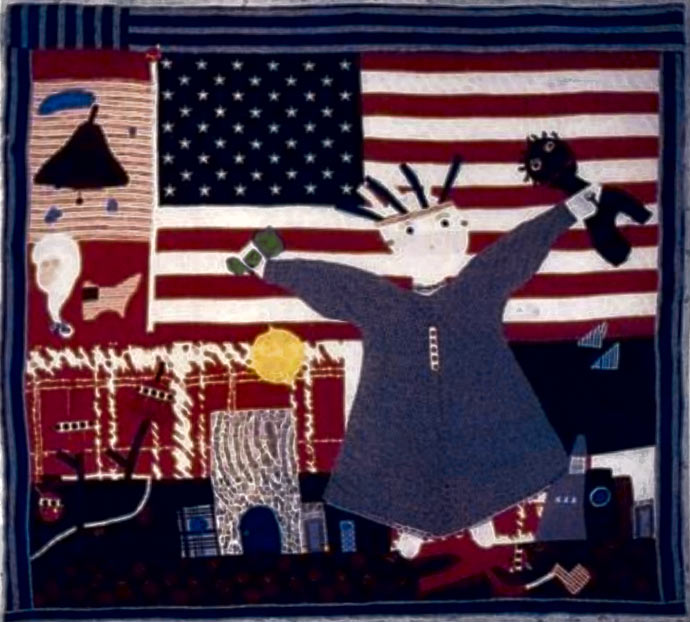
For a million years--34, to be exact--the sixth-grade gym teacher at Westlawn Middle School in Tuscaloosa was Yvonne Wells. So far as I could tell, Ms. Wells was a perfectly normal physical education teacher, who probably went home hoarse every night after a hard day's work.
When she got home, she took up her needle and thread and scissors and spread out her fabrics on the living room floor and went to work quilting. Sometimes she stayed up half the night. She'd had no training in quilt-making, and when she tried to reproduce the old patterns, she felt frustrated and dissatisfied with the results. Gradually, she abandoned traditional patchwork for her own intensely personal, and often political, storytelling style of quilt.
Wells sells her quilts at festivals and in galleries; almost all her work, she says, winds up hanging on the wall instead of laying across a bed. Her style has attracted attention far beyond Tuscaloosa, and in recent years her work has been featured in traveling exhibits at museums all over the country. Half a dozen of her quilts, including this one, are now part of the permanent collection of the International Quilt Study Center and Museum in Nebraska.
What we see here is the Statue of Liberty holding dollar bills in one hand and a black person, perhaps a child, in the other, while she stomps on an Indian with both feet. The title pretty much says it: Being In Total Control of Herself, B.I.T.C.H.
Tuscaloosa
Alabama
art
Yvonne Wells
Statue of Liberty
quilt
Westlawn Middle School
teacher
Jan 5, 2010

All five Stein boys touched down in Tuscaloosa, Alabama, a few days ago and claimed the beachhead for the Crimson Tide. That's not very hard to do in Tuscaloosa.
The occasion was the premier social event of the year, on New Year's Day, the wedding of Neely Sims and Damon Ray.
Tuscaloosa
Alabama
night
Crimson Tide
John
Joe
Ted
Allen
Hank
Jan 12, 2010

The Waterford crystal over in aisle 12 is going for $30,000. Well, truth is, it's not for sale, but as a piece of crystal it's worth $30,000, and last Saturday, you could get your picture taken with it in front of the Dr. Pepper display as part of a sponsorship deal. The University of Alabama won the crystal football championship trophy last week by beating Texas in the Rose Bowl, and first thing they did was put the trophy on display over at the Wal-Mart SuperCenter on Skyland Boulevard in Tuscaloosa.
Here are some of the thousands of fans who stood in line to pose with it.
When I first heard that the University of Alabama would be displaying the crystal football in . . . Wal-Mart . . . I was certain my proverbial leg was being proverbially pulled. But google it yourself; it really happened, though spokespeople for the University claim that the Wal-Mart tour was not their idea. I guess I've just been gone from Tuscaloosa for way too long.
University of Alabama
Tuscaloosa
football
Wal-Mart
(Image credit: Birmingham News)
Jan 18, 2010

Neely and Damon were married on New Year's Day, 2010, in Tuscaloosa. The cake decorations are just what they look like: American childhood delicacies.
Tuscaloosa
Alabama
wedding
twinkies
hostess cupcakes
little debbie cakes
Jan 20, 2010
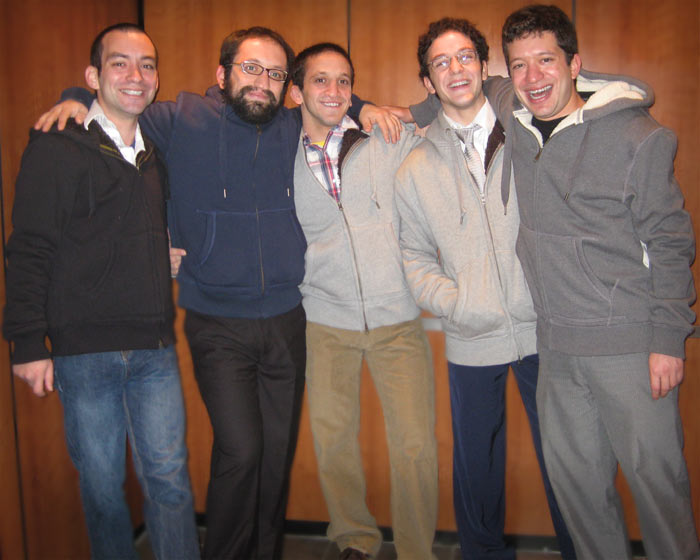
All five Stein brothers in an elevator, on the first day of 2010.
From left to right: #3, #1, #4, #5, #2 (1981, 1978, 1988, 1992, 1979).
Tuscaloosa
Alabama
John Stein
Ted Stein
Allen Stein
Hank Stein
Joseph Stein
elevator
Dec 19, 2010

Young Hanky got himself into this pose all by himself, with no help from Photoshop. The flexible back and seriously sturdy neck would serve him well athletically when he became a high school wrestler, but back in 1998, when this photo was probably taken, he had other interests, notably Beanie Babies. Rumor has it that as of this weekend, he's finished his first semester of college and shipped his snowboard back to Maine for some serious semester break.
Tuscaloosa
Alabama
kids
Hank Stein
yard
contortion
May 1, 2011
 On Wednesday, 27 April 2011, an outbreak of severe tornadoes unmatched in the U.S. since 1932 destroyed homes and neighborhoods across the Southeast from Mississippi to Virginia. Hundreds of people died.
On Wednesday, 27 April 2011, an outbreak of severe tornadoes unmatched in the U.S. since 1932 destroyed homes and neighborhoods across the Southeast from Mississippi to Virginia. Hundreds of people died.
This is what one of the storms did to the house in Tuscaloosa where we raised our children. At least I think that's what we're looking at here; if it's not our old house, it's the house next door; there's not enough left to know for certain. The picture is disorienting in part because the house in the foreground near the waterfront, amongst the trees, must have been blown in by the storm from somewhere else; none of the houses on that side of Forest Lake was built so close to the water.
It's been forty years since an American city was shredded like this by an EF5 tornado, with winds exceeding 200 miles per hour; the last such storm was in 1970, when 26 people died in Lubbock, Texas. Wednesday's storm crossed through the middle of Tuscaloosa from southwest to northeast, devastating a path up to a mile and a half wide--about as wide as tornado paths ever get, according to the meteorological commentary I have been reading obsessively.
In some spots, winds were so strong that they ripped up the pavement and tore culverts out of the ground.
Our old neighborhood, Forest Lake, is pretty much in the geographic center of town. Most of it is gone now. The neighborhood just to the northeast, Cedar Crest, was hit even worse, if you can imagine that, and beyond Cedar Crest the neighborhood of Alberta City was completely obliterated, many houses reduced to clean slabs, with the debris sucked so high into the sky it returned to earth fifty or even a hundred miles away.
The house we lived in before this one was also destroyed, as was the elementary school all five of our boys attended.
We've been able to get in touch with almost all our old friends and neighbors, and they seem to be among the relatively lucky Tuscaloosans--homeless in some cases, but safe and sound. As of Saturday, the local death toll was 39 but expected to climb as rescue crews complete their search through the ruins.
More than 5,000 houses are damaged, and over 1,000 people have been treated for injuries at the hospital.
From now on, life in Tuscaloosa will be divided into a before and an after.
Tuscaloosa
Alabama
Forest Lake
tornado
home
May 12, 2011
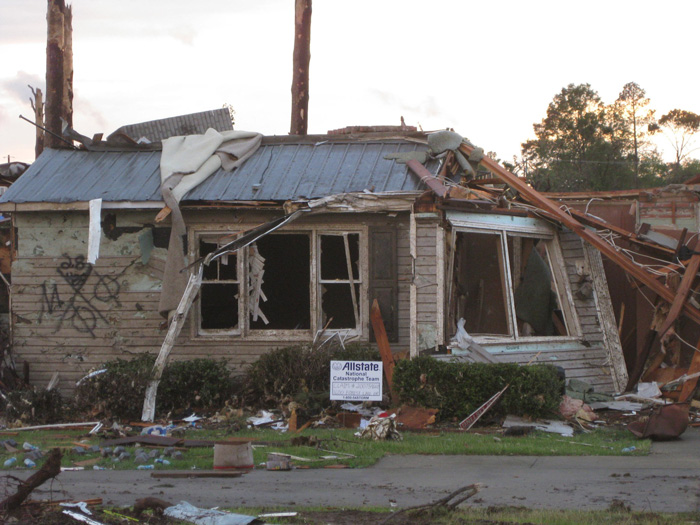 The April 27 tornado that stayed on the ground for more than eighty miles through Tuscaloosa and Birmingham, Alabama, has now been classified F4, not F5, as I mistakenly indicated in a posting here on May 1. There were three definite F5 tornadoes that same day, including one in north Alabama that completely obliterated the town of Hackleburg.
The April 27 tornado that stayed on the ground for more than eighty miles through Tuscaloosa and Birmingham, Alabama, has now been classified F4, not F5, as I mistakenly indicated in a posting here on May 1. There were three definite F5 tornadoes that same day, including one in north Alabama that completely obliterated the town of Hackleburg.
But F4 is plenty bad enough. Forty-one people died in Tuscaloosa.
This is what's left of our old house. It was a two-story house, but the second story was set back a bit, and it's completely gone. At the extreme right of the picture is the doorframe for the front door, which is gone. At left is a spray-painted "Katrina cross" indicating that the rubble was searched on April 28 by search team "M," and no people or pets were found.
Tuscaloosa
Alabama
house
ruins
tornado
(Image credit: Ben Shankman)
Jun 9, 2011
 On April 28, 2011, the visible-light and infrared sensors of NASA's ASTER satellite captured this image of Tuscaloosa County, Alabama, which had been raked by an especially large and powerful tornado just the day before.
On April 28, 2011, the visible-light and infrared sensors of NASA's ASTER satellite captured this image of Tuscaloosa County, Alabama, which had been raked by an especially large and powerful tornado just the day before.
Infrared sensors are useful for distinguishing between vegetated and non-vegetated land cover. The pink areas in the photo represent vegetation–forests, pastures, cropland, golf courses. Areas that show up as aqua are non-vegetated or very lightly vegetated–cities, highways, rivers, strip mines, recent clearcuts.
The tornado track is obvious here: a straight aqua-colored streak running from the southwest to the northeast. Vegetation in this streak that was not directly destroyed by the storm was so littered with pieces of buildings and household objects that satellite sensors could barely detect it.
Just north of the storm track is the twisting course of the Black Warrior River, which shows up in aqua. The city of Tuscaloosa is mostly south of the river, at the left edge of the picture. In the upper left corner of the picture is Lake Tuscaloosa, a dammed-up tributary to the Black Warrior that provides the city's drinking water.
NASA's spokespeople assert that images such as this one can be useful in the aftermath of storms. They may help identify storm-damaged places outside of populated areas, where tornadoes might escape public awareness. And by proving the time and location of tornado paths, they could help homeowners support their insurance claims for storm damages.
If you click on the picture to see the larger version, you can follow numerous roads out into the countryside and observe that many of them seem to end with a little dot of aqua, indicating a non-vegetated spot. These are well pads for methane rigs. About fifteen years ago, the Black Warrior basin was the scene of one of the nation's first methane gas drilling booms. Coalfields underlie much of west Alabama, including almost all of Tuscaloosa County, but until recently the methane gas associated with coal deposits was considered a danger rather than an economically valuable fuel. "Fracking" technology, in which high-pressure liquids are injected deep into the earth to crack open the rocks hosting methane, was developed and refined in Alabama; drilling for methane is now under way all over the world. Unlike oil or traditional natural gas, methane is best extracted by small wells located within a few hundred feet of numerous other small wells; thus, the countryside is speckled with hundreds or thousands of separate well pads.
Tuscaloosa
Alabama
birdseye view
infrared
satellite imagery
tornado
methane
fracking
(Image credit: NASA ASTER satellite)
(h/t: Chuck Horowitz
Jan 19, 2012

Crazy weather in Alabama this winter, so warm and rainy that the daffodils burst into bloom in mid-January, about six weeks early. And then, of course, a cold front came crashing down; Anna Singer picked these blooms and got them into the house hours before the mercury fell to 23 degrees.
Tuscaloosa
Alabama
flowers
daffodils
(Image credit: Anna Singer)
Mar 23, 2012
 Last week, the Forest Lake homeowners' association in Tuscaloosa, Alabama, began siphoning the water out of Forest Lake, in hopes of revealing the debris that has collected in the lake since Tuscaloosa was devastated by a monster tornado eleven months ago.
Last week, the Forest Lake homeowners' association in Tuscaloosa, Alabama, began siphoning the water out of Forest Lake, in hopes of revealing the debris that has collected in the lake since Tuscaloosa was devastated by a monster tornado eleven months ago.
The lake sits in the geographic center of Tuscaloosa and was near the center of the tornado track. Virtually all the surrounding houses were destroyed, along with the trees that gave the neighborhood its name.
Yesterday, when the water had dropped to the level seen in this photo, engineers were able to make preliminary estimates of the cost of debris removal: just under $300,000, about 30% less than anticipated. Even though the lake is privately owned by the homeowners' association, the taxpayers will be paying for cleanup; the city hopes to share the cost with the U.S. Department of Agriculture Natural Resrouces Conservation Service.
Tuscaloosa
Alabama
Forest Lake
tornado
storm
debris
(Image credit: Chris Pow, al.com)
Jun 20, 2012
 They say we could hit 100 today, or if not today then tomorrow. Which of course brings to mind the proverbial cold day in . . . Alabama, back in approximately 1989, when Forest Lake froze over solid and young Ted put on a scarf and a red hat and went out for an adventure on ice. You may be able to make out a dark blob just behind his left shoulder; that was a log we put out to set a limit on the adventure; beyond that point, we weren't sure how thin the ice might be, and Alabama kids didn't know from thin ice.
They say we could hit 100 today, or if not today then tomorrow. Which of course brings to mind the proverbial cold day in . . . Alabama, back in approximately 1989, when Forest Lake froze over solid and young Ted put on a scarf and a red hat and went out for an adventure on ice. You may be able to make out a dark blob just behind his left shoulder; that was a log we put out to set a limit on the adventure; beyond that point, we weren't sure how thin the ice might be, and Alabama kids didn't know from thin ice.
The thing about a cold day in Alabama is: if it's cold enough to freeze a lake, it's certainly cold enough to freeze everybody's plumbing, which is not insulated well enough to function in serious winter. We had an ax that we used to chop holes in that ice so we could get buckets of water to keep the toilet flushing.
Tuscaloosa
Alabama
kids
Forest Lake
winter
Ted
ice
Dec 5, 2012
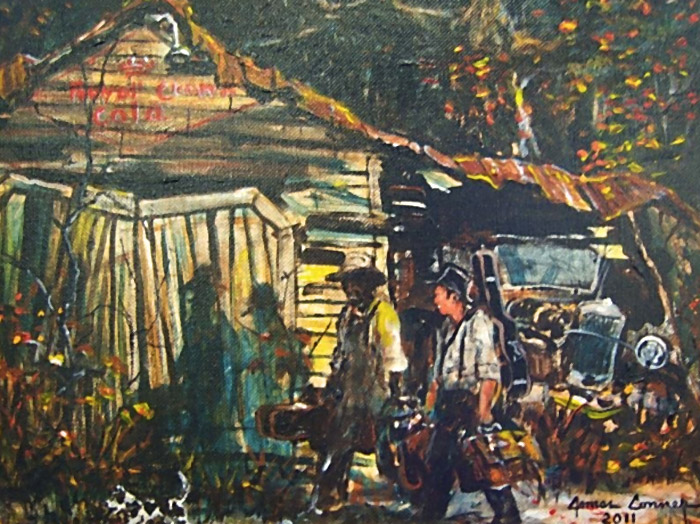 Music Pals For a Lifetime, by James Conner.
Music Pals For a Lifetime, by James Conner.
Conner grew up in rural Noxubee County, Mississippi, where he learned to draw from correspondence lessons off the back of a matchbook. He left Mississippi after high school, first for Vietnam and then for about twenty years in Detroit, where he worked as a police sketch artist. But the downward spiral of layoffs that was crushing Detroit eventually reached into the police force and claimed Conner's job.
He was devasted, he said, until he realized that losing his job meant he could finally go home. He'd been homesick his whole adult life, missing Mississippi.
He was no longer young by the time he got back home, but he married and started a family and went back to school, studying art at the University of Mississippi. He taught art for a while, then took the plunge and became a fulltime painter. He said he was trying to become the black Grandma Moses.
Like Grandma Moses, he is drawn to images from his rural childhood. He seems homesick still for his southern roots. But unlike Grandma Moses, Conner is a trained artist with a twenty-first-century eye, and he is a black artist, with a complicated relationship to southern experience.
In this painting and many others, young men carrying guitar cases venture out into the world. In some of the paintings, they travel, perform, try to make something of themselves. In some, they are headed back home again, for whatever reasons. In at least one of Conner's works, the man with the guitar is stuck in the crossroads. I like this picture; the guys with guitars have places to go, dreams to work out, and probably hard times ahead, but at least they've got each other.
Tuscaloosa
Alabama
Detroit
Mississippi
James Conner
Noxubee County
Feb 10, 2013
 Shown here in a curled-up polaroid snapshot from a nightstand drawer, eating shrimp on a kitchen table covered with newspaper, probably in 1985 or 1986, back when they were shrimpy little kids and pretty good friends, are Joe Stein and Stephanie Jacobs.
Shown here in a curled-up polaroid snapshot from a nightstand drawer, eating shrimp on a kitchen table covered with newspaper, probably in 1985 or 1986, back when they were shrimpy little kids and pretty good friends, are Joe Stein and Stephanie Jacobs.
Stephanie and Joe went to preschool together and then to University Place Elementary, and for many years they went to the same after-school program and the same Sunday school.
Based on this picture, we might guess that Stephanie liked milk with her shrimp, or else liked milk but not shrimp, or perhaps liked neither but had been told to drink her milk.
Joe appears to be a serious shrimp-peeler, despite wearing an obviously unserious sort of hat.
Both Stephanie and Joe have gone back to school in recent years at the University of Alabama, Stephanie for a library science master's in book arts and Joe for a music degree in piano performance.
Tuscaloosa
Alabama
Joe
Stephanie
1985?
1701 5th Avenue
kitchen table
Polaroid
Nov 30, 2013
 Juniper Self, shown here with her mother Daphne, came dressed to cheer at Bryant-Denny Stadium last week for her first Alabama football game. The Crimson Tide beat University of Tennessee–Chattanooga, 49–0.
Juniper Self, shown here with her mother Daphne, came dressed to cheer at Bryant-Denny Stadium last week for her first Alabama football game. The Crimson Tide beat University of Tennessee–Chattanooga, 49–0.
Today's Iron Bowl game at Auburn is for all the marbles. Roll Tide Roll.
Tuscaloosa
sports
football
Alabama
Daphne
cheerleader
Juniper
(h/t: Scott Self)
Aug 21, 2014
 At the Waysider in Tuscaloosa, where another semester and another football season are already so close you can taste them.
At the Waysider in Tuscaloosa, where another semester and another football season are already so close you can taste them.
Tuscaloosa
Alabama
food
restaurant
couple
Waysider
(Image credit: Little Fuji)
Feb 10, 2016
 This is the earliest known photo of all five boys, taken at Forest Lake, Tuscaloosa, in November or December of 1992.
This is the earliest known photo of all five boys, taken at Forest Lake, Tuscaloosa, in November or December of 1992.
For what it's worth, all the trees in the background are gone now, shredded by the tornado in 2011. The boys, however, are still going strong: from left to right, there's Joe, now 34; Allen, 27; Ted, 36; John, who just turned 38; and bobble-headed newborn Hank, who's now 23.
Tuscaloosa
Alabama
sunset
John
Joe
Ted
Allen
Hank
boys
Steins
May 31, 2016

When Joe got back to Tuscaloosa this month after his semester in Cuba, he had fish to check up on.
He's a fisherman and also sort of a fish collector; for the past year or so, he'd been raising baby fish from the Black Warrior River, the little bream and other small fry that would normally be thrown back into the river. Joe kept dozens of them in a large aquarium in his living room, and dozens more in a pool in a tiny creek that runs into the Black Warrior near downtown Tuscaloosa. He named them and fed them and got kind of attached to them.
But when he left for Cuba in January, he moved all his fish to the little creek and wished them well. They were on their own.
Happily, they survived the winter, though heavy rains apparently washed them downstream into a different pool. In this picture, Joe was walking along a drainpipe that criss-crossed his creek, trying to see how his babies were doing. They were growing and swimming actively and doing all the right fishy sorts of things.
Joe now is living in Philadelphia, where he has a bowl of goldfish. He's completed all his coursework and will graduate in August from the University of Alabama.
Tuscaloosa
fish
Joe Stein
creek
fishing
Black Warrior River
bream
Jan 8, 2017
 Snow fell on Alabama the other day, and bitter cold settled in. Same thing happened there back in about 1989, when Forest Lake in Tuscaloosa froze up thick enough to run around and slide on, and our three eldest posed for a picture on the ice.
Snow fell on Alabama the other day, and bitter cold settled in. Same thing happened there back in about 1989, when Forest Lake in Tuscaloosa froze up thick enough to run around and slide on, and our three eldest posed for a picture on the ice.
From the bottom: Ted, John, Joe. Note the complete absence of gloves or mittens, and the general inadequacy of winter apparel. In his hat and jacket, Ted appeared to have a chance of staying warm, but the other two just had to tough it out. There is no evidence in this picture of the socks-on-the-hands and/or plastic-bags-in-the-shoes that we recall improvising for wintry moments in Alabama; nonetheless, they all somehow survived.
Tuscaloosa
Alabama
Forest Lake
brothers
winter
John
Joe
Ted
ice
(Image credit: old family snap)
Feb 26, 2017
 Joe and his friend Beau pose for a picture last spring in Beau's new food truck, Local Roots, which plies the streets of Tuscaloosa serving an international menu that features locally grown foods.
Joe and his friend Beau pose for a picture last spring in Beau's new food truck, Local Roots, which plies the streets of Tuscaloosa serving an international menu that features locally grown foods.
Tuscaloosa
Alabama
food
Joe Stein
work
restaurant
food truck
Beau Burroughs
(Image credit: the phone)
Feb 28, 2017
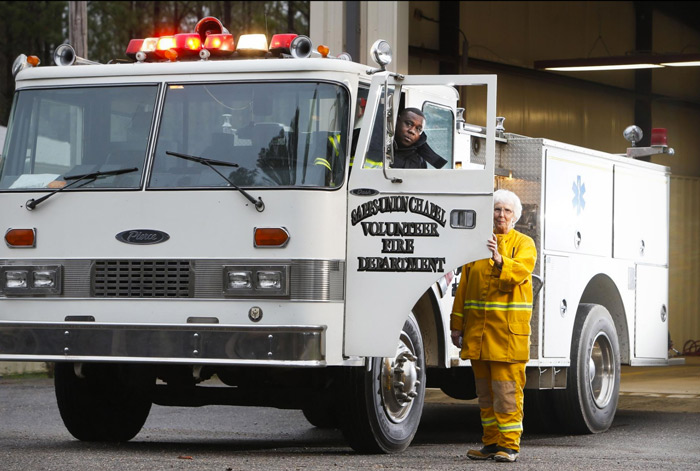 After 15 years of service in a city fire department, which likely involved one or more calls a day, every day, round the clock, round the year, a fire engine is pretty well beat up.
After 15 years of service in a city fire department, which likely involved one or more calls a day, every day, round the clock, round the year, a fire engine is pretty well beat up.
If it's well worn but not completely used up at that point, it goes into the city's reserve fleet, to replace newer equipment that's out of service for repairs or maintenance.
After 5 or so years of reserve duty, it's surplus; maintenance at that point is costly, and there is newer equipment falling into reserve status.
So 20-year-old firetrucks go on the market, at a steep discount, and the purchasers typically are small, volunteer fire departments, which could never afford the $500,000 or more needed to buy a new pumper vehicle.
The duty level expected of the old truck isn't nearly as heavy with a volunteer force, where it might be called out for fires only a few times a year instead of several times a day.
The fire engine pictured here was bought new by the Tuscaloosa City Fire Department in 1984; twenty years later, it was sold to the Sapps–Union Chapel Volunteer Fire Department in nearby Pickens County, which is still using it in 2017 and plans to keep running it forever.
Posing with it are Assistant Chief Troy Jordan and Fire Chief Pauline Hall.
Tuscaloosa
Alabama
Troy Jordan
Pickens County
1984 model
fire engine
Sapps–Union Chapel Volunteer Fire Department
Pauline Hall
(Image credit: Gary Cosby Jr. for the Tuscaloosa News)
Mar 12, 2017

John must have been about eight years old when he came across the special offer in a seed catalog: hey kids, add a penny of your own money to your parents' seed order, and you'll get a super fantastic packet of seeds just for you to plant.
If I remember correctly, we taped the penny to the order form, and I got my seeds and he got his. Both our gardens did pretty well that summer, thanks to the good advice of our neighbor on Fifth Avenue in Tuscaloosa, Mr. Crawford. John's turnip, shown here, must have been exactly the super fantastic return he'd been hoping for on his investment–and yup, he's still a gardener today, thirty years later.
At harvest time, he posed for a Polaroid snapshot in the kitchen with his brothers, Joe and Ted. Joe appears to be checking out a previously shot Polaroid, probably watching the colors emerge magically from the paper. Ted appears to be annoyed. Jealous maybe, of his brother's turnip?
Tuscaloosa
garden
John
Joe
Ted
Fifth Avenue
seeds
turnip
1986
Apr 27, 2017
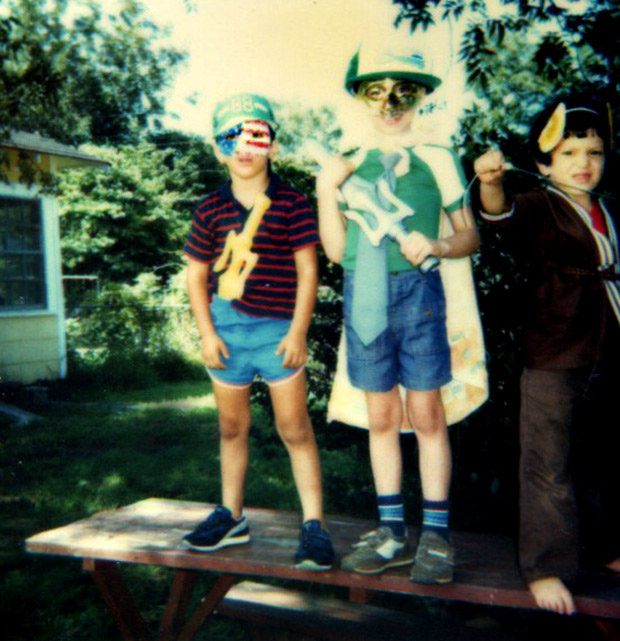
These picnic table warriors from the late 1980s successfully repelled would-be invaders from our backyard on 5th Avenue in Tuscaloosa. That's John at left, Ted at right, and their friend Scott Cartwright in the middle.
Tuscaloosa
children
John
Ted
backyard
costumes
Scott Cartwright
face paint
1987?
picnic table
(scanned Polaroid)

















 Music Pals For a Lifetime, by James Conner.
Music Pals For a Lifetime, by James Conner. Shown here in a curled-up polaroid snapshot from a nightstand drawer, eating shrimp on a kitchen table covered with newspaper, probably in 1985 or 1986, back when they were shrimpy little kids and pretty good friends, are Joe Stein and Stephanie Jacobs.
Shown here in a curled-up polaroid snapshot from a nightstand drawer, eating shrimp on a kitchen table covered with newspaper, probably in 1985 or 1986, back when they were shrimpy little kids and pretty good friends, are Joe Stein and Stephanie Jacobs. Juniper Self, shown here with her mother Daphne, came dressed to cheer at Bryant-Denny Stadium last week for her first Alabama football game. The Crimson Tide beat University of Tennessee–Chattanooga, 49–0.
Juniper Self, shown here with her mother Daphne, came dressed to cheer at Bryant-Denny Stadium last week for her first Alabama football game. The Crimson Tide beat University of Tennessee–Chattanooga, 49–0.






